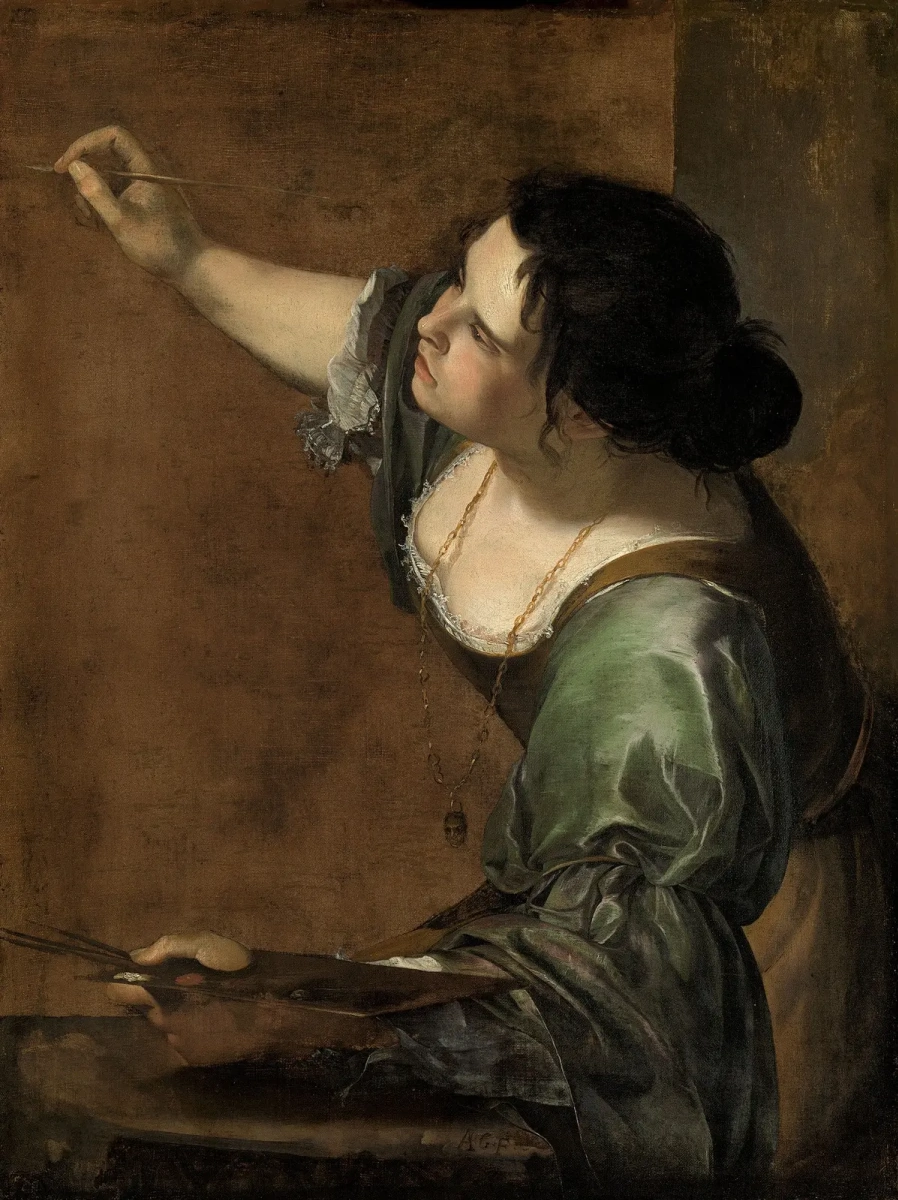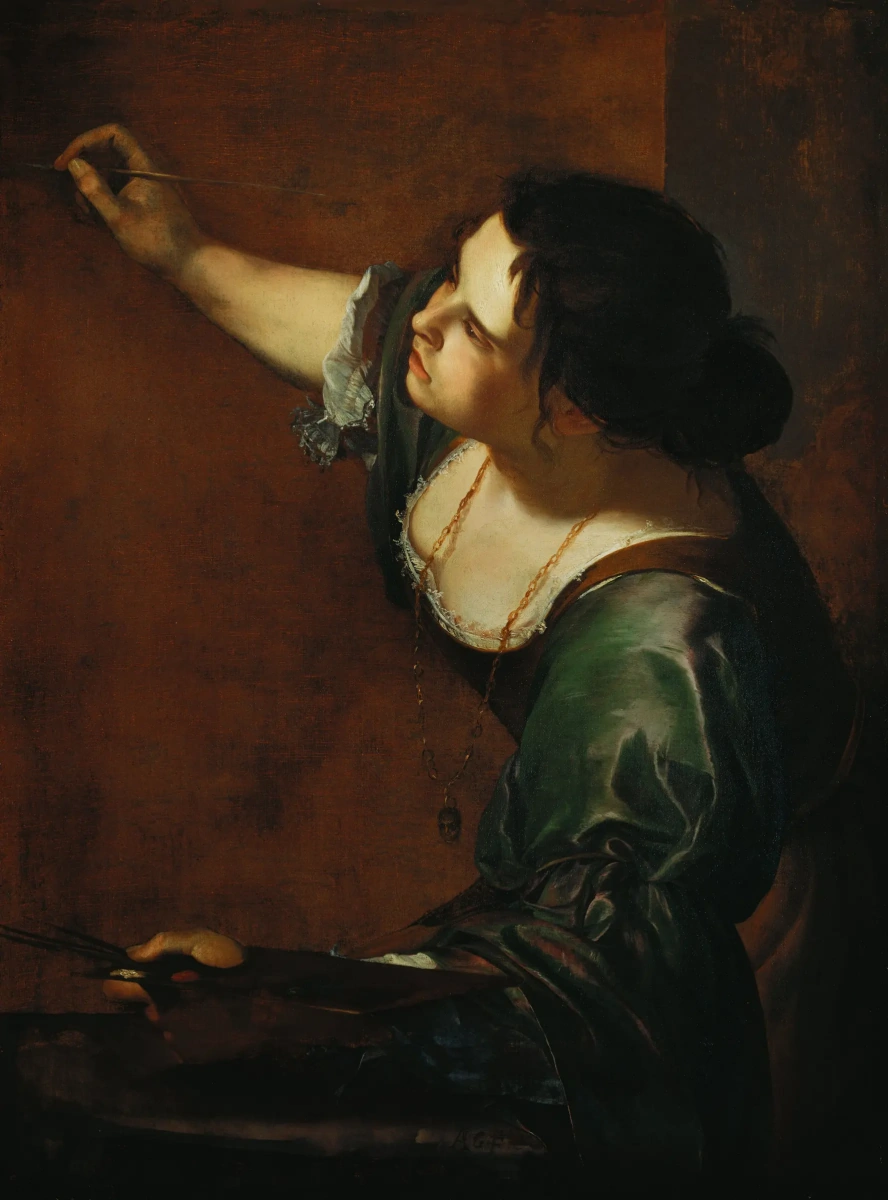log in
Enter site
Login to use Arthive functionality to the maximum
Self-portrait in the form of an allegory of painting
Artemisia Gentileschi • Pintura, 1630-e
, 96.5×73.7 cm












Descripción del cuadro «Self-portrait in the form of an allegory of painting»
Among all the self portraits of Artemisia Gentileschi (1, 2a masterpiece is this one - relatively late, British. Contrast chiaroscuro and distinctive color recall the lessons she learned in her youth Caravaggio, and a very unusual perspective is explained simply: whenever a mirror stood before a primed canvas, on which Artemisia works, she would turn her head slightly and see herself in that position.
If the dating of the picture is correct, then Artemisia should be about forty-five. She is the mother of four children - two dead boys and two surviving girls, one of whom is illegitimate, and the milestones of Artemisia’s lived life are like stages of an adventure novel. At the age of 12 she began to study painting. At 17 she was raped by her teacher perspective Agostino Tassi. At 18 survived a loud trial in Rome, offense on father, on lover and on all men in a crowd. At 19 she hurriedly married an almost random person and left for Florence. There, despite scandalous fame, she achieved success, the patronage of the Medici family, friendship with Galileo and even (the first among women!) Membership in the Florentine Academy of Fine Arts. However, she had to be content with private orders: a woman was not supposed to be public and well paid. Dropping everything, risked moving to Naples. There she struggled with the wild customs of competing artists and even received a weapon permit. Achieved a long-awaited order for fresco painting in the town Pitstsuoli. She continued to suffer misunderstandings and financial difficulties. She decided to go to Britain - a country with a disgusting climate and lack of artistic tradition.
Artemisia - the name given to her at birth - translated from Italian means "sagebrush". Despite the phenomenal energy and enviable strength of mind, Artemisia has experienced a lot of bitterness in her lifetime. "Self-portrait in the form of an allegory of painting" - its manifesto, the approval of the right to be called a major artist. At the time, it was an extremely bold idea - to depict oneself in the form of an allegory of painting, with soiled wrists and a pendant in the shape of a dead head. But Artemisia believed that she deserved such a right.
This wonderful self-portrait was written approximately in the years 1638-1639, when the Italian Artemisia moved to England, where she was persistently called by the British monarch Charles V. He was the first of the rulers of Foggy Albion, who was eager to collect as much as possible under the arches of Winzdor Castle more famous European masters - Spaniards, Italians, Dutch. On this wave, the Flemish became his court portrait painter. Anthony van Dyck; even the aged Orazio Gentileschi, father of Artemisia, received an order for the ceiling painting of the Greenwich residence. Artemisia herself before that age of 20 had not seen her father: she could not forgive him. England was able to reconcile them and return a quarter of a century ago, when they together - the master and his assistant - worked on the paintings of Roman churches. In the French-Italian film Artemisia (1997) there is even a frame where the artist presents this work to the father, a self-portrait, and Orazio exclaims: "You have become a terrific artist, my Artemisia!"
In the British royal collection "Self-portrait in the form of an allegory of painting" Artemisia Gentileschi is kept to this day.
Author: Anna Yesterday
If the dating of the picture is correct, then Artemisia should be about forty-five. She is the mother of four children - two dead boys and two surviving girls, one of whom is illegitimate, and the milestones of Artemisia’s lived life are like stages of an adventure novel. At the age of 12 she began to study painting. At 17 she was raped by her teacher perspective Agostino Tassi. At 18 survived a loud trial in Rome, offense on father, on lover and on all men in a crowd. At 19 she hurriedly married an almost random person and left for Florence. There, despite scandalous fame, she achieved success, the patronage of the Medici family, friendship with Galileo and even (the first among women!) Membership in the Florentine Academy of Fine Arts. However, she had to be content with private orders: a woman was not supposed to be public and well paid. Dropping everything, risked moving to Naples. There she struggled with the wild customs of competing artists and even received a weapon permit. Achieved a long-awaited order for fresco painting in the town Pitstsuoli. She continued to suffer misunderstandings and financial difficulties. She decided to go to Britain - a country with a disgusting climate and lack of artistic tradition.
Artemisia - the name given to her at birth - translated from Italian means "sagebrush". Despite the phenomenal energy and enviable strength of mind, Artemisia has experienced a lot of bitterness in her lifetime. "Self-portrait in the form of an allegory of painting" - its manifesto, the approval of the right to be called a major artist. At the time, it was an extremely bold idea - to depict oneself in the form of an allegory of painting, with soiled wrists and a pendant in the shape of a dead head. But Artemisia believed that she deserved such a right.
This wonderful self-portrait was written approximately in the years 1638-1639, when the Italian Artemisia moved to England, where she was persistently called by the British monarch Charles V. He was the first of the rulers of Foggy Albion, who was eager to collect as much as possible under the arches of Winzdor Castle more famous European masters - Spaniards, Italians, Dutch. On this wave, the Flemish became his court portrait painter. Anthony van Dyck; even the aged Orazio Gentileschi, father of Artemisia, received an order for the ceiling painting of the Greenwich residence. Artemisia herself before that age of 20 had not seen her father: she could not forgive him. England was able to reconcile them and return a quarter of a century ago, when they together - the master and his assistant - worked on the paintings of Roman churches. In the French-Italian film Artemisia (1997) there is even a frame where the artist presents this work to the father, a self-portrait, and Orazio exclaims: "You have become a terrific artist, my Artemisia!"
In the British royal collection "Self-portrait in the form of an allegory of painting" Artemisia Gentileschi is kept to this day.
Author: Anna Yesterday
Publicaciones sobre la obra





